Major advances in the treatment of lung cancer, specifically targeted therapies and immunotherapies, have demonstrated a survival benefit in clinical trials. To measure the effects of these advances at the population level, researchers at the National Cancer Institute (NCI), part of the National Institutes of Health, conducted an analysis of the US Surveillance, Epidemiology, and End Results (SEER) database of patients with non-small cell lung cancer (NSCLC) and SCLC from 2001 through 2016. SEER captures high-quality, reliable cancer registry data that can be used to calculate population-level mortality attributable to particular tumor types, or “incidence-based mortality”.
The researchers noted that the rate of mortality from NSCLC decreased faster than incidence. Incidence of NSCLC among men decreased by 1.9% annually from 2001 through 2008, and then more steeply—by 3.1% annually—from 2008 through 2016. Incidence-based mortality among men decreased by 3.2% annually from 2006 through 2013, then decreased more quickly—by 6.3% annually—from 2013 through 2016. Among women, incidence remained steady until 2006, when it decreased by 1.5% annually through 2016. Incidence-based mortality in women decreased slowly from 2006 through 2014 (2.3% annually), then at a faster rate of 5.9% annually from 2014 through 2016.
Two-year relative survival also improved greatly among the entire population, regardless of race or ethnicity. Among men with NSCLC, 2-year survival rose from 26% for those diagnosed in 2001 to 35% among those diagnosed in 2014. Comparatively, 2-year relative survival was consistently higher among women, improving from 35% in 2001 to 44% in 2014. The researchers noted that the decline in mortality from NSCLC began to accelerate in 2013, coinciding with FDA approval of targeted therapies and the recommendation for routine genetic testing for molecular alterations in EGFR and ALK.
Among patients with SCLC, mortality and incidence decreased at a similar rate among men and women. The decrease in SCLC mortality was attributed to the decrease in incidence, as treatment options remain limited for this lung cancer subtype. However, recent studies of immunotherapy strategies have shown promising results.
High Altitude: This analysis shows that at the population level, advances in identifying and treating cancers with phenotypes that depend on ALK and EGFR have contributed to significant improvements in lung cancer survival. Additionally, the approval of effective immune-based therapies for patients with PD-1-/PD-L1 expression has impacted survival rates among some patients. Continued research and monitoring of trends in lung cancer according to histologic type and stage, and pilot projects linking registry data with oncology practice claims data, may enable more specific treatment analyses for improved outcomes in the future.
Ground Level: Practicing oncologists have been armed with vast improvements in the treatment of lung cancer during the past decade. The discovery that the presence of an oncogenic driver mutation (eg, ALK, EGFR) can be predictive of response to specific targeted therapies has greatly improved survival among patients with NSCLC and ALK and EGFR mutations. The subsequent development of immune-based therapies, specifically, PD-1/PD-L1 inhibitors, has also contributed to improved outcomes in both NSCLC and SCLC. With continued therapeutic advances and monitoring of trends, researchers are optimistic that the rate of lung cancer survival will continue to increase.

